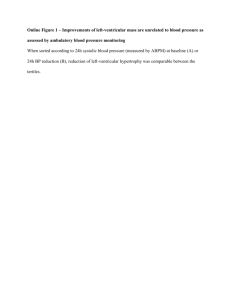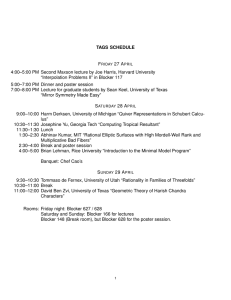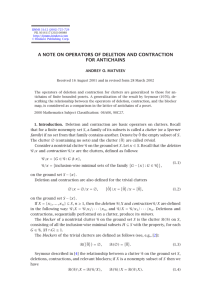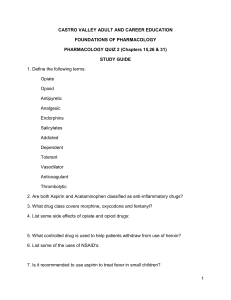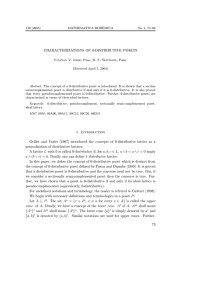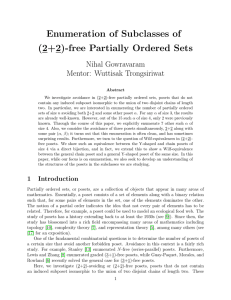ON BLOCKERS IN BOUNDED POSETS ANDREY O. MATVEEV
advertisement
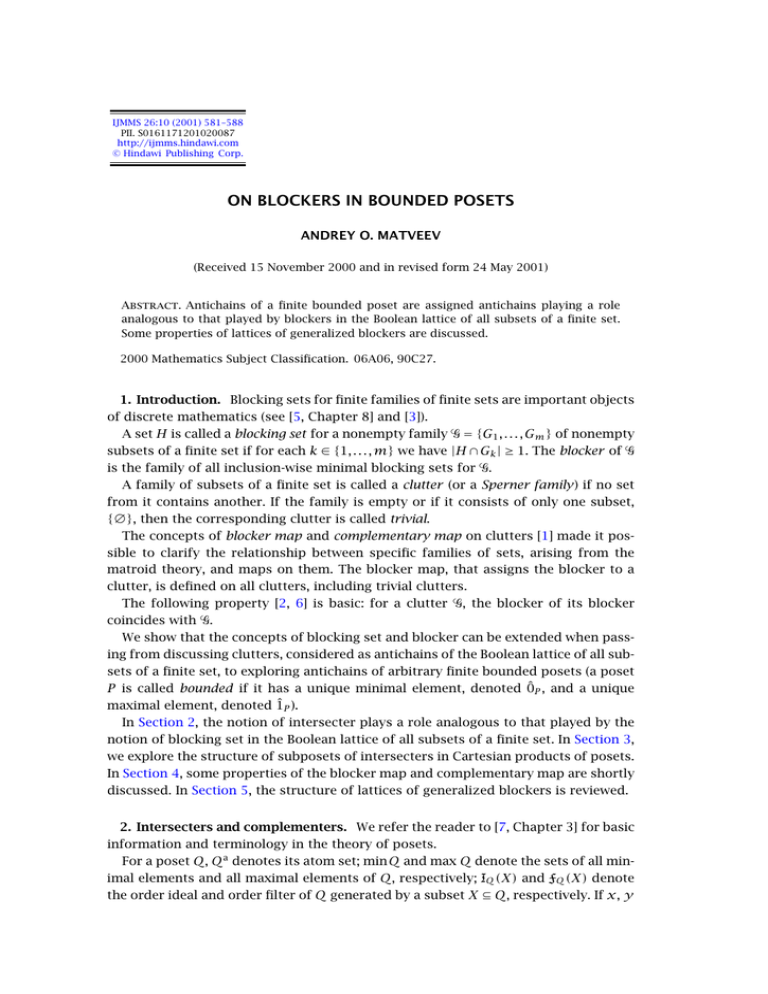
IJMMS 26:10 (2001) 581–588
PII. S0161171201020087
http://ijmms.hindawi.com
© Hindawi Publishing Corp.
ON BLOCKERS IN BOUNDED POSETS
ANDREY O. MATVEEV
(Received 15 November 2000 and in revised form 24 May 2001)
Abstract. Antichains of a finite bounded poset are assigned antichains playing a role
analogous to that played by blockers in the Boolean lattice of all subsets of a finite set.
Some properties of lattices of generalized blockers are discussed.
2000 Mathematics Subject Classification. 06A06, 90C27.
1. Introduction. Blocking sets for finite families of finite sets are important objects
of discrete mathematics (see [5, Chapter 8] and [3]).
A set H is called a blocking set for a nonempty family Ᏻ = {G1 , . . . , Gm } of nonempty
subsets of a finite set if for each k ∈ {1, . . . , m} we have |H ∩Gk | ≥ 1. The blocker of Ᏻ
is the family of all inclusion-wise minimal blocking sets for Ᏻ.
A family of subsets of a finite set is called a clutter (or a Sperner family) if no set
from it contains another. If the family is empty or if it consists of only one subset,
{∅}, then the corresponding clutter is called trivial.
The concepts of blocker map and complementary map on clutters [1] made it possible to clarify the relationship between specific families of sets, arising from the
matroid theory, and maps on them. The blocker map, that assigns the blocker to a
clutter, is defined on all clutters, including trivial clutters.
The following property [2, 6] is basic: for a clutter Ᏻ, the blocker of its blocker
coincides with Ᏻ.
We show that the concepts of blocking set and blocker can be extended when passing from discussing clutters, considered as antichains of the Boolean lattice of all subsets of a finite set, to exploring antichains of arbitrary finite bounded posets (a poset
P is called bounded if it has a unique minimal element, denoted 0̂P , and a unique
maximal element, denoted 1̂P ).
In Section 2, the notion of intersecter plays a role analogous to that played by the
notion of blocking set in the Boolean lattice of all subsets of a finite set. In Section 3,
we explore the structure of subposets of intersecters in Cartesian products of posets.
In Section 4, some properties of the blocker map and complementary map are shortly
discussed. In Section 5, the structure of lattices of generalized blockers is reviewed.
2. Intersecters and complementers. We refer the reader to [7, Chapter 3] for basic
information and terminology in the theory of posets.
For a poset Q, Qa denotes its atom set; min Q and max Q denote the sets of all minimal elements and all maximal elements of Q, respectively; IQ (X) and FQ (X) denote
the order ideal and order filter of Q generated by a subset X ⊆ Q, respectively. If x, y
582
ANDREY O. MATVEEV
are elements of Q and x < y (or x ≤ y), then we write x <Q y (or x ≤Q y). In a similar
way, we denote by ∨Q the operation of join in a join-semilattice Q, and we denote by
∧Q the operation of meet in a meet-semilattice Q. We use × to denote the operation
of Cartesian product of posets.
For a finite family Ᏻ of finite sets, its conventional blocker is denoted by Ꮾ(Ᏻ).
Throughout P stands for a finite bounded poset with |P | > 1. We start with extending the concept of blocking set.
Definition 2.1. Let A be a subset of P .
• If A ≠ ∅ and A ≠ {0̂P }, then an element b ∈ P is an intersecter for A in P if for
every a ∈ A − {0̂P }, we have
IP (b) ∩ IP (a) ∩ P a ≥ 1.
(2.1)
• If A = {0̂P } then A has no intersecters in P .
• If A = ∅ then every element of P is an intersecter for A in P .
• Every non-intersecter for A in P is a complementer for A in P .
Let ᏸ denote a finite Boolean lattice. If A is a nonempty subset of the poset ᏸ −{0̂ᏸ },
then an element b ∈ ᏸ is an intersecter for A in ᏸ if and only if Iᏸ (b)∩ ᏸa is a blocking
set for the family {Iᏸ (a) ∩ ᏸa : a ∈ A}.
We denote by I(P , A) and C(P , A) the sets of all intersecters and all complementers
for A in P , respectively. We consider the sets I(P , A) and C(P , A) as subposets of the
poset P . For a one-element set {a} we write I(P , a) instead of I(P , {a}) and C(P , a)
instead of C(P , {a}).
˙ C(P , A) = P . For a nonempty subset A ⊆ P −{0̂P }, the
We have the partition I(P , A) ∪
subposets of all its intersecters and complementers are nonempty; indeed, we have
I(P , A) 1̂P and C(P , A) 0̂P . It follows from Definition 2.1 that for such a subset A,
we have
I(P , A) = I(P , min A),
C(P , A) = C(P , min A),
(2.2)
therefore, in most cases, we may restrict ourselves to considering intersecters and
complementers for antichains; further,
I(P , A) =
I(P , a),
a∈A
C(P , A) =
C(P , a).
(2.3)
a∈A
For all antichains (including the empty antichain) A1 , A2 of P with FP (A1 ) ⊆ FP (A2 ),
we have
C P , A1 ⊆ C P , A2 .
(2.4)
I P , A1 ⊇ I P , A2 ,
Clearly, the subposet I(P , a) of all intersecters for an element a ∈ P is the order filter
FP (IP (a) ∩ P a ), hence, in view of (2.3), equality (2.5) in the following lemma holds.
Lemma 2.2. Let A be a nonempty subset of P − {0̂P }. The subposet of all intersecters
for A in P is determined by the following equivalent equalities:
I(P , A) =
a∈A
FP IP (a) ∩ P a ,
(2.5)
ON BLOCKERS IN BOUNDED POSETS
I(P , A) =
E∈Ꮾ({IP (a)∩P a :a∈A})
e∈E
Proof. To prove (2.6), note that the inclusion
I(P , A) ⊇
E∈Ꮾ({IP (a)∩P a :a∈A})
follows from the definition of intersecters.
We are left with proving the inclusion
I(P , A) ⊆
E∈Ꮾ({IP (a)∩P a :a∈A})
583
FP (e).
(2.6)
FP (e)
(2.7)
FP (e).
(2.8)
e∈E
e∈E
Assume that it does not hold, and consider such an intersecter b for A that b ∈
E∈Ꮾ({IP (a)∩P a :a∈A}) e∈E FP (e). In this case, the inclusion b ∈
e∈E FP (e) holds not for
all sets E from the family Ꮾ({IP (a) ∩ P a : a ∈ A}), hence there exists such an element
a ∈ A that |IP (b) ∩ IP (a) ∩ P a | = 0. Therefore b is not an intersecter for A, but this
contradicts our choice of b. Hence, (2.6) holds.
Thus, for every subset A of the poset P , the subposet of all intersecters for A in P is
an order filter of P , that is, I(P , A) = FP (min I(P , A)). As a consequence, the subposet
C(P , A) of all complementers for A in P is the order ideal IP (max C(P , A)).
If A is a subset of the poset P then we call the antichain min I(P , A) the blocker of A
in P . We call elements of the blocker min I(P , A) minimal intersecters for A in P , and
we call elements of the antichain max C(P , A) maximal complementers for A in P .
The images of intersecters under suitable order-preserving maps are also intersecters.
Proposition 2.3. Let P1 and P2 be disjoint finite bounded posets with |P1 |, |P2 | > 1.
Let ψ : P1 → P2 be an order-preserving map such that
ψ 0̂P1 = 0̂P2 ,
ψ x1 >P2 0̂P2 ,
∀x1 >P1 0̂P1 .
(2.9)
For every subset A1 of P1
ψ I P1 , A1 ⊆ I P2 , ψ A1 .
(2.10)
Proof. There is nothing to prove for A1 = ∅ ⊂ P and A1 = {0̂P1 }. So suppose that
A1 ≠ ∅ ⊂ P and A1 ≠ {0̂P1 }. Let b1 be an intersecter for A1 . According to Definition 2.1,
for all a1 ∈ A1 , a1 >P1 0̂P1 , we have |IP1 (b1 ) ∩ IP1 (a1 ) ∩ P1 a | ≥ 1, and in view of (2.9),
for every atom z1 ∈ IP1 (b1 ) ∩ IP1 (a1 ) ∩ P1 a we have the inclusion
IP2 ψ z1 ∩ P2 a ⊆ IP2 ψ a1 ∩ P2 a ,
(2.11)
the left-hand part of which is nonempty. Hence, for all a2 ∈ ψ(A1 ) the inclusion b1 ∈
I(P , A1 ) implies that
IP ψ b1 ∩ IP ψ a1 ∩ P2 a ≥ 1.
2
2
This means that ψ(b1 ) ∈ I(P2 , ψ(A1 )) and completes the proof.
(2.12)
584
ANDREY O. MATVEEV
3. Intersecters in Cartesian products of posets. In this section, we study the structure of subposets of intersecters in Cartesian products of two finite posets.
Proposition 3.1. Let P1 and P2 be disjoint finite bounded posets with |P1 |, |P2 | > 2.
Let Q denote the poset
˙ 0̂Q , 1̂Q ,
P1 − 0̂P1 , 1̂P1 × P2 − 0̂P2 , 1̂P2 ∪
(3.1)
where 0̂Q and 1̂Q are the adjoint new least and greatest elements. Let A be a nonempty
subset of the poset Q − {0̂Q , 1̂Q }, and let AP1 and AP2 denote the subsets {a1 ∈ P1 :
(a1 ; a2 ) ∈ A} and {a2 ∈ P2 : (a1 ; a2 ) ∈ A}, respectively.
(i) If min I(P1 , AP1 ) = {1̂P1 } or min I(P2 , AP2 ) = {1̂P2 }, then
I(Q, A) = min I(Q, A) = 1̂Q .
(3.2)
(ii) If min I(P1 , AP1 ) ≠ {1̂P1 } and min I(P2 , AP2 ) ≠ {1̂P2 }, then
˙ 1̂Q ,
I(Q, A) = I P1 , AP1 − 1̂P1 × I P2 , AP2 − 1̂P2 ∪
(3.3)
and min I(Q, A) = min I(P1 , AP1 ) × min I(P2 , AP2 ).
Proof. The atom set Qa of the poset Q is P1 a ×P2 a , therefore, by (2.5), the subposet
of intersecters for A in Q is
I(Q, A) =
FQ
IP1 a1 × IP2 a2 ∩ P1 a × P2 a
(a1;a2 )∈A
˙ 1̂Q ,
= I P1 , AP1 − 1̂P1 × I P2 , AP2 − 1̂P2 ∪
(3.4)
and the statement follows.
Proposition 3.2. Let P1 and P2 be disjoint finite bounded posets with |P1 |, |P2 | > 1.
Let Q denote the poset P1 × P2 , and let A be a nonempty subset of the poset Q − {0̂Q }.
Then
I(Q, A) =
P1 × I P2 , a2 ∪ I P1 , a1 × P2 .
(3.5)
(a1;a2 )∈A
Proof. Since the atom set Qa of the poset Q is ({0̂1 }×P2 a )˙
∪(P1 a ×{0̂2 }), we have,
according to equality (2.5),
I(Q, A) =
FQ
(a1;a2 )∈A
=
a ˙ P1 × 0̂2
IP1 a1 × IP2 a2 ∩
0̂1 × P2 a ∪
FQ
˙ IP1 a1 ∩ P1 a × 0̂2
0̂1 × (IP2 a2 ∩ P2 a ∪
,
(3.6)
(a1 ;a2 )∈A
and the statement follows.
4. Blocker map and complementary map. Let Ᏺ(P ) denote the distributive lattice
of all order filters (partially ordered by inclusion) of P , and let A(P ) denote the lattice
585
ON BLOCKERS IN BOUNDED POSETS
of all antichains of P . For antichains A1 , A2 ∈ A(P ), we set
A1 ≤A(P ) A2
iff FP A1 ⊆ FP A2 ;
(4.1)
in other words, we make use of the isomorphism Ᏺ(P ) → A(P ): F min F . We call the
least element 0̂A(P ) = ∅ ⊂ P and greatest element 1̂A(P ) = {0̂P } of the lattice A(P ) the
trivial antichains of P . They are counterparts of trivial clutters.
Recall (cf. [4]) that for A1 , A2 ∈ A(P ),
A1 ∨A(P ) A2 = min A1 ∪ A2 ,
A1 ∧A(P ) A2 = min FP A1 ∩ FP A2 .
(4.2)
Let b : A(P ) → A(P ) be the blocker map on A(P ); by definition,
b : A → min I(P , A).
(4.3)
In particular, for every a ∈ P , a >P 0̂P , we have b({a}) = IP (a) ∩ P a . We also have
b(∅ ⊂ P ) = 0̂P ,
b
0̂P
= ∅ ⊂ P.
(4.4)
For a one-element antichain {a}, we write b(a) instead of b({a}).
If A is a nontrivial antichain of P then Lemma 2.2 implicitly states the following
equalities in A(P ):
b(A) =
{e} =
a∈A e∈b(a)
E∈Ꮾ({b(a):a∈A})
e∈E
{e}.
(4.5)
Let B(P ) denote the image of A(P ) under the blocker map. The set B(P ) is equipped,
by definition, with the partial order induced by the partial order on A(P ). For a blocker
B ∈ B(P ), the subposet b−1 (B) = {A ∈ A(P ) : b(A) = B} is the preimage of B under the
blocker map.
The following lemma is a reformulation of (2.4).
Lemma 4.1. If A1 , A2 ∈ A(P ) and A1 ≤A(P ) A2 then b(A1 ) ≥B(P ) b(A2 ).
Definition 2.1 implies the following reciprocity property for intersecters: for every
antichain A of P , we have
A ⊆ I P , b(A) .
(4.6)
In the theory of blocking sets the following fact is basic.
Proposition 4.2 (see [2, 6]). For any clutter Ᏻ, Ꮾ(Ꮾ(Ᏻ)) = Ᏻ.
This statement may be generalized in the following way.
Theorem 4.3. The restriction map b|B(P ) is an involution, that is, for each blocker
B ∈ B(P ), b(b(B)) = B.
Proof. There is nothing to prove for the trivial blockers B = 0̂ B(P ) = ∅ ⊂ P and
B = 1̂B(P ) = {0̂P }. So suppose that B is nontrivial. Choose an arbitrary antichain A ∈
b−1 (B). With regard to reciprocity property for intersecters, every element of A is an
intersecter for the antichain B = b(A ). In other words, for each element a ∈ A we
586
ANDREY O. MATVEEV
have the inclusion a ∈ I(P , B) = b∈B FP (b(b)). Taking this inclusion into account, we
assign to the antichain A the antichain
A = min
FP b(b) ∈ b−1 (B),
(4.7)
b∈B
which is the blocker of B, by (2.5). Then b(A) = B, b(B) = A, and the theorem
follows.
By Lemma 2.2, a nontrivial antichain A of P , considered as an element of A(P ),
is a fixed point of the blocker map on A(P ) if and only if A = ∧a∈A ∨e∈b(a) {e} or,
equivalently, A = ∨E∈Ꮾ({b(a):a∈A}) ∧e∈E {e}. We study the structure of a preimage of the
blocker map.
Theorem 4.4. For each blocker B ∈ B(P ), its preimage b−1 (B) is a join-subsemilattice
of the lattice A(P ).
Proof. There is nothing to prove for a trivial blocker B, so suppose that B is nontrivial. Choose two antichains A1 , A2 ∈ b−1 (B). According to (4.5), we have the following equalities in the lattice A(P ):
B = b A1 =
{e} = b A2 =
a1 ∈A1 e∈b(a1 )
Therefore
B=
{e}.
(4.8)
a2 ∈A2 e∈b(a2 )
{e} = b A1 ∨A(P ) A2 .
(4.9)
a∈A1 ∨A(P ) A2 e∈b(a)
Hence A1 ∨A(P ) A2 ∈ b−1 (B).
The greatest element of b−1 (B) is b(B).
Let c : A(P ) → A(P ) be the complementary map on A(P ); by definition,
c : A → max C(P , A).
(4.10)
In particular, we have c(∅ ⊂ P ) = ∅ ⊂ P and c({0̂P }) = {1̂P }.
Let C(P ) denote the image of A(P ) under the complementary map. The set C(P )
is equipped, by definition, with the partial order induced by the partial order on the
distributive lattice of order ideals of P : for C1 , C2 ∈ C(P ), we set C1 ≤C(P ) C2 if and
only if IP (C1 ) ⊆ IP (C2 ).
5. Lattice of blockers. In this section, we study the structure of the poset of blockers in P .
Lemma 5.1. The poset B(P ) of blockers in P is a meet-subsemilattice of the lattice
A(P ).
Proof. We have to prove that for all B1 , B2 ∈ B(P ), it holds B1 ∧A(P ) B2 ∈ B(P ).
There is nothing to prove when one of the blockers B1 , B2 is trivial. Suppose that both
B1 and B2 are nontrivial. With the help of Theorem 4.3, we write
B1 ∧A(P ) B2 = b b B1 ∧A(P ) b b B2 .
(5.1)
587
ON BLOCKERS IN BOUNDED POSETS
According to (4.5), we have the following equalities in A(P ):
B1 ∧A(P ) B2 =
a1 ∈b(B1 ) e∈b(a1 )
=
{e} ∧A(P )
{e}
a2 ∈b(B2 ) e∈b(a2 )
{e} = b b B1 ∨A(P ) b B2 ∈ B(P ).
(5.2)
a∈b(B1 )∨A(P ) b(B2 ) e∈b(a)
Lemma 5.2. The meet-semilattice B(P ) is self-dual.
Proof. Let B1 , B2 ∈ B(P ). If B1 ≤B(P ) B2 then B1 ≤A(P ) B2 , and we see that b(B1 ) ≥B(P )
b(B2 ), by Lemma 4.1.
Conversely, the relation b(B1 ) ≥B(P ) b(B2 ) implies the relation B1 = b(b(B1 )) ≤B(P )
B2 = b(b(B2 )), in view of Theorem 4.3 and Lemma 4.1.
Because the restriction map b|B(P ) is bijective, we see that it is an anti-automorphism
of B(P ).
We now summarize the information of this section.
Theorem 5.3. The poset B(P ) is a lattice with the least element 0̂ B(P ) = ∅ ⊂ P and
greatest element 1̂B(P ) = {0̂P }. The unique atom of B(P ) is b(P a ), and the unique coatom of B(P ) is P a . Moreover,
(i) the poset B(P ) is a meet-subsemilattice of the lattice A(P ),
(ii) the lattice B(P ) is self-dual,
(iii) in the lattice B(P ) the operations of meet and join are determined as follows: for
B1 , B2 ∈ B(P ),
B1 ∧B(P ) B2 = B1 ∧A(P ) B2 ,
(5.3)
B1 ∨B(P ) B2 = b b B1 ∧A(P ) b B2 .
(5.4)
Proof. The only missing step is to prove (5.4), but the equality B1 ∨B(P ) B2 =
b(b(B1 ) ∧B(P ) b(B2 )) immediately follows from the self-duality of the lattice B(P ), in
view of the existence of its anti-automorphism b|B(P ) . With the help of equality (5.3),
we obtain (5.4).
We call the lattice B(P ) the lattice of blockers in the poset P . It follows immediately
from the definition of the complementary map that its restriction c|B(P ) : B(P ) → C(P ),
B c(B), is an isomorphism of B(P ) into the lattice C(P ).
References
[1]
[2]
[3]
[4]
R. Cordovil, K. Fukuda, and M. L. Moreira, Clutters and matroids, Discrete Math. 89 (1991),
no. 2, 161–171. MR 92d:05040. Zbl 739.05019.
J. Edmonds and D. R. Fulkerson, Bottleneck extrema, J. Combinatorial Theory 8 (1970),
299–306. MR 40#8440. Zbl 218.05006.
Z. Füredi, Matchings and covers in hypergraphs, Graphs Combin. 4 (1988), no. 2, 115–206.
MR 89i:05214. Zbl 820.05051.
C. Greene and D. J. Kleitman, The structure of Sperner k-families, J. Combinatorial Theory
Ser. A 20 (1976), no. 1, 41–68. MR 53#2695. Zbl 363.05006.
588
[5]
[6]
[7]
ANDREY O. MATVEEV
M. Grötschel, L. Lovász, and A. Schrijver, Geometric Algorithms and Combinatorial Optimization, 2nd ed., Algorithms and Combinatorics, vol. 2, Springer-Verlag, Berlin,
1993. MR 95e:90001. Zbl 837.05001.
A. Lehman, A solution of the Shannon switching game, J. Soc. Indust. Appl. Math. 12 (1964),
687–725. MR 30#3463. Zbl 137.38704.
R. P. Stanley, Enumerative Combinatorics. Vol. 1, Cambridge Studies in Advanced Mathematics, vol. 49, Cambridge University Press, Cambridge, 1997. MR 98a:05001.
Zbl 889.05001.
Andrey O. Matveev: Data-Center Company, RU-620034, P.O. Box 5, Ekaterinburg,
Russia
E-mail address: aomatveev@dc.ru

